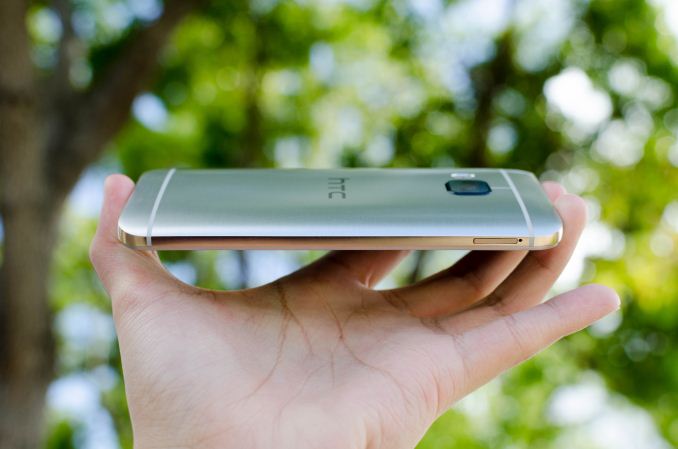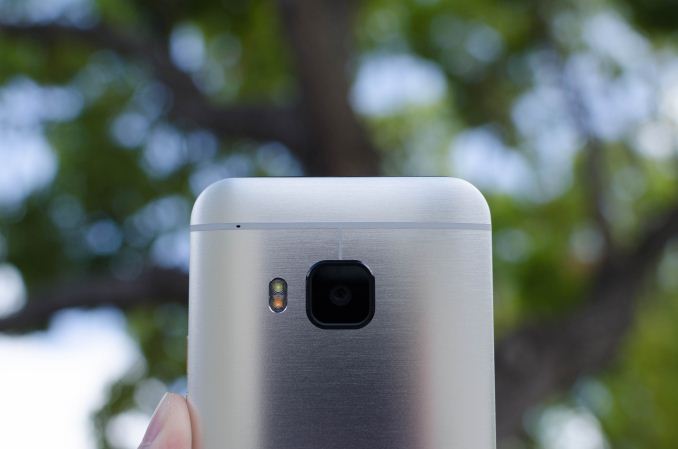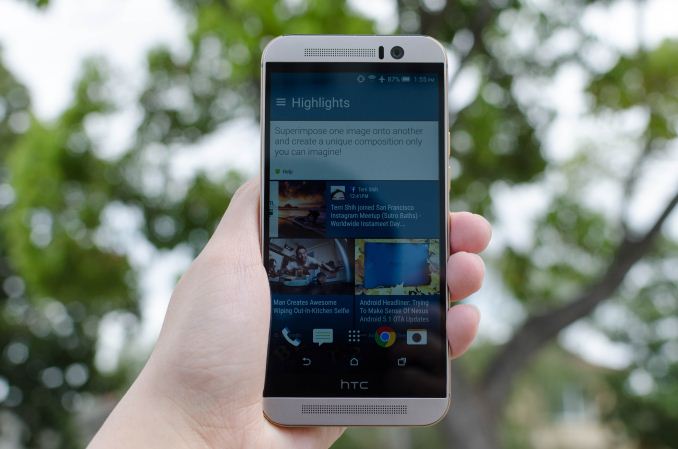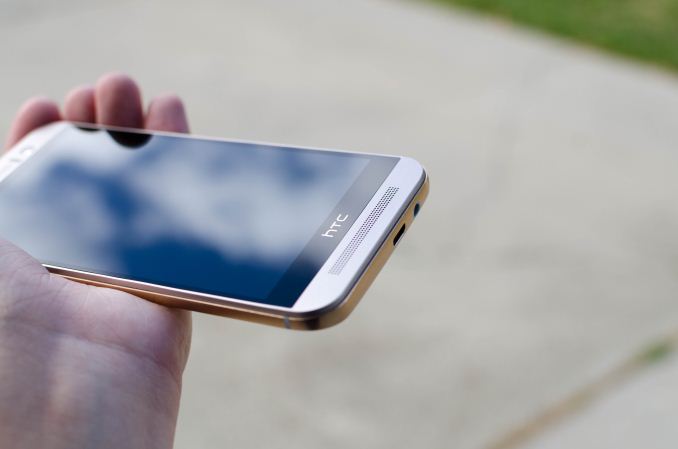The HTC One M9 Review: Part 1
by Joshua Ho on March 22, 2015 7:00 PM EST- Posted in
- Smartphones
- HTC
- Qualcomm
- Mobile
- Snapdragon 810
- One M9
Initial Conclusions
Overall, the One M9 is a pretty significant device for HTC and really sets the tone for the entire year, so it’s well worth going over everything again before we draw any conclusions about the One M9. However, any of these initial thoughts will be limited in their scope because it isn’t really possible to characterize HTC’s camera performance, nor the performance of Snapdragon 810 under load at this time due to HTC's last-minute software update. We can only really look at some key areas like the display, battery life, and SoC performance, along with design and software.
To start, HTC has done a decent job of refreshing the One design for the M9 with their new brushed finish and dual anodization process. HTC has also finally moved the power button to the right side of the phone, and improved the fit and finish of the plastic front bezel. However, there are a lot of missing details that one might have expected from a refinement of a previous design. The power button on the side ends up a bit too low for most people as far as I can tell, and ends up being rather easy to accidentally press and is also being difficult to press intentionally. The volume buttons are also easily confused for the power button, even with the textured pattern on the power button to avoid confusion. The back cover does have a nice feel, but the hard edge between the back and sides of the phone is just too sharp for everyday use and the front bezel is too far separated from the back cover to really make sense. It’s obvious that the bezel on the front of the phone can’t be eliminated, but the arrangement of the bezel combined with on screen buttons really affects the ergonomics of the device. The M7’s keyboard feels comfortably placed in comparison to the M8 and M9, which seem too tall for comfortable typing.
SoC performance is a mild improvement over Snapdragon 805, and a significant improvement in GPU over Snapdragon 801. However, it’s definitely alarming at how small the differences are when Snapdragon 810 is placed in a phone, and it seems that the thermal output of the Snapdragon 810 is high enough that sustained tests end up placing it somewhere around the range of the Snapdragon 805 in CPU-bound tests. In GPU performance, the improvements over the Snapdragon 805’s Adreno 420 are generally somewhat minimal, which really justifies HTC’s decision to go with a 1080p display for the M9.
Unfortunately, in battery life HTC manages to fall somewhat flat as the combination of the Snapdragon 810 and the loss of panel self-refresh causes a significant regression in battery life despite the increase in battery size. I’m not sure how much HTC could’ve done to prevent this, but the removal of PSR is definitely something HTC could’ve kept to try and keep battery life similar to the One M8. This is really the first generation to my memory that actually regressed on battery life in our benchmarks, which is concerning for any device with a Snapdragon 810 SoC. It may be that this is just HTC’s problem, but given that HTC has generally managed to do well at extracting maximum battery efficiency from previous platforms I’m not sure if other OEMs will be able to improve the situation here.
The display is one of the more disappointing aspects of the One M9 thus far. Although the 1080p resolution isn’t really a problem in actual use, the lack of improvement or regression in every other metric suggests that HTC has gone backwards in display quality. Combined with the removal of PSR, it’s concerning to see that cost optimization has affected such a crucial aspect of the smartphone experience. Overall, even when comparing against 2014 smartphones the One M9 ends up closer to the bottom for display quality.
The software experience seems to be one area where HTC continues to do relatively well compared to most Android OEMs, and Sense 7 remains a relatively enjoyable experience. However, the new additions to Sense 7 aren’t really all that helpful. There’s a lot of effort spent on introducing new features like additional personalization and some new widgets and applications, but none of this really feels well-differentiated, and there isn’t much change to the rest of the UI to make it mesh with Lollipop’s UI. It also seems that Snapdragon 810 causes some minor performance issues, but the effects of this are incredibly minor and it’s hard to tell whether this is due to random variance to some extent.
Although we’re still missing some of the pieces, based upon what data we have the One M9 is in an alarming place for a new smartphone. It’s pretty rare that a new phone ends up regressing in almost every major way compared to an old phone, but the One M9 ends up doing this in display and battery life. The SoC is better, but I can’t help but feel that Snapdragon 805 ends up being a better choice than Snapdragon 810 for a flagship smartphone at this time. The Snapdragon 808 may be better suited as an upgrade to the Snapdragon 805, but given the performance of the 810 I’m not really holding my breath. Given all of these issues, I’m almost tempted to point to the One M8 as the better phone, but until we get the full picture we won’t be coming to any final conclusions about the One M9.
















132 Comments
View All Comments
Midwayman - Tuesday, March 24, 2015 - link
With android it almost always seems to be misbehaving apps. Its hard to compare unless you keep the OS stock. I've spent a fair amount of time chasing down wakelocks.Notmyusualid - Sunday, March 22, 2015 - link
My gf noticed too.She went to buy a new Windows phone after she 'fell' into the pool this weekend, drowining the Nokia 820 I bought her. Ok, I dunked her...
But alas the top models were out of stock at the biggest shopping center available. Eventually she left with a Galaxy A7 (Octa core, 5.5" 1080, fast ram, dual sim) and whilst I'm impressed, she, not too much. She really wanted a Windows Phone it seems.
zodiacfml - Monday, March 23, 2015 - link
I feel bad. They've focused too much on the physical materials of the phone, hurting the other parts.They could have also went for a larger display at the same resolution to increase battery size and minimize bezels.
This will be competing with the S6 which is the phone to get in 2015 because of its very nice camera.
mchart - Monday, March 23, 2015 - link
A larger display is not what it needs. What it needs is the same display but in a chassis that is smaller and doesn't have all that useless area needlessly increasing the size of the phone.Impulses - Monday, March 23, 2015 - link
Pretty underwhelming, I'm starting to wonder whether I'll hold on to my current phone even longer than 2 years, it's the first one I've had for more than a year as it is. Z3c was the only thing that tempted me last year...mchart - Monday, March 23, 2015 - link
IMO the Z3C is the best phone in the market. It's just a shame it's been largely ignored.I'm an iPhone fan and the Z3C is the first Android running hardware that hasn't led to disappoint for me. Great battery life, great build quality, feels nice in normal usage, has top end hardware packed in, and is running pretty much vanilla Android.
It can be had for a really great price now too. Low $400s, and you can get it in that same price range direct from Sony with a 1 year warranty if you make a free student account to receive 10% off through them.
It's really the best phone if you can't stand/deal with these larger monsters that are frankly a pain to use on a day to day basis for simple things like phone calls.
sonny73n - Monday, March 23, 2015 - link
The Z3C has a few problems. It would be the best phone in the market if it had better display and protective glass. I wish my Z3C has the same display quality as the M7 and Gorilla 3 front and back glass.mchart - Monday, March 23, 2015 - link
The z3 has gorilla glass front and back. The display is high quality as well. It's just not 1080p. The ppi is still high enough for that size though.V900 - Monday, March 23, 2015 - link
Yeah, 1080p is really overkill for a phone right around 4 inches. I honestly couldn't tell the difference between 1080p 720p and the 1136*640 on a 4 inch screen in regular usage. As long as it's above 300 PPI few people would be able to tell...Impulses - Monday, March 23, 2015 - link
If I was buying a phone today I'd probably pick it over my Nexus 5 (are they even still selling the N5?), tho I'd have to switch carriers for it... I'm satisfied with Sprint in my area for now and that's one of the reasons I've kept the N5.A Z3c with Qi wireless charging and OIS would be the perfect compact Android phone IMO. Hopefully Sony doesn't abandon smaller devices (or the smartphone market altogether) any time soon.
Whatever they follow up the Z3c might just be the replacement for the N5 I've had since Nov 2013... I had three HTC phones before the, pretty happy with them, the One just hasn't done it for me.
Ergonomically it's always felt odd and it seems they're treading water in most other senses (no pun intended).